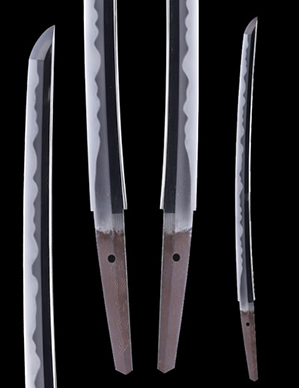Echigo Kanesada, aka: Terukane
This marvelous wakizashi is a complete joy to study as a textbook example of superb Osaka Shinto workmanship.
Darcy Brockbank wrote an excellent overview of this smith and with his generous permission I have excerpted part of it here:
- Terukane originally signed Echigo no Kami Kanesada like his teacher, and when his high level of skill became evident, Shodai Kanesada adopted him into his family (relationships of choice like this were apparently considered deep bonds in old Japan). After the death of the Shodai in 1666, Terukane abdicated the rights to the name Echigo no Kami Kanesada to the Shodai’s young biological son, and began signing Terukane. This is something that I find illustrates a particular strength of character, to give up his name in this fashion.
- Terukane is rated Jo-jo Saku by Fujishiro, near the top of his school and times, and 850 man yen in the Toko Taikan, making him highly valued, as much as some great smiths of the koto period. (I have seen Juyo Token katana by this smith offered for sale in Japan between $66,000 and $80,000 USD). He is also rated as O-wazamono with a reputation for producing very sharp swords. Only 16 kaji rate higher at Sai-jo Wazamono, the highest rating.
- Osaka Shinto is a particularly beautiful style, though possibly criticized for focusing more on aesthetics than on functionality. The school produced mostly wakizashi and katana, with few tanto. The sugata is expected to have little sori, with a slightly extended chu-kissaki. The hada one expects from Osaka Shinto is a very fine and beautiful ko-mokume, one that seems to have a sheen or almost an internal glow to it.
- The hamon will be mostly thick nioi; as for pattern, it will run the full gamut of possibilities. Furthermore, several new hamon styles were invented by Osaka Shinto smiths. One key kantei point though is the straight Osaka yakidashi that will then usually expand into a notare or midare based hamon. The boshi will usually be a ko-maru in suguba regardless of the hamon.
- For Terukane in particular his hada was similar in ways to Shodai Kanesada, his teacher. In addition, his was clear, extremely fine and tight and in some cases almost muji (undiscernable), with bright ji nie. The hamon on his works was a toran midare or gonome midare similar to Sukehiro, mixed with yahazu midare. It will be bordered on one side with fine ji nie, and on the other with thick nioi, and full of ashi and sunagashi. To my eye, the hamon looks cold and frosty, as the thick and wide nioi resemble crystals of ice and snow within the hamon.
- Terukane’s skill was very high, and there are currently over 80 Juyo Token to his credit, and some of them are Tokubetsu Juyo. There are 40 each signed Terukane and Echigo no Kami Kanesada.
As Darcy clearly defines, this smith is identified as a leading maker of the 17th century with works occupying the position of rank in the Juyo and Tokubetsu Juyo ranks which is difficult for Shinto swords to achieve. Furthermore, the fact that there are wakizashi by him under both his former and latter names casts further light on how well he is regarded among his shinto peers, as Shinto wakizashi of Juyo rank are remarkably rare.
This sword was found in a pawn shop many years ago and was restored by the current owner. It turned out to be quite the find, as it is a magnificent example of Osaka Shinto workmanship, with all the characteristics and quality that one would expect from a smith of this caliber. It is stout, and healthy with excellently forged koitame hada that has a fine luster of fine chikei and abundant sparkling jinie.
The deep gunome midare hamon is a highly skilled composition of fantastic bright konie that resembles hoarfrost (frozen water vapor) with a depth of texture and consistency throughout that is truly lovely and remarkable. Within the hamon are contained superb kinsuji, sunagashi, with deep ashi inserted, and floating above it are a couple round, deliberate tobiyaki that look as if they are being tossed about on rolling seas.
The boshi is deep and healthy with visible konie continuing through it from the hamon and into the kaeri crossing short across the koshinogi.
- Nagasa: 54 cm
- Motohaba: 3.3 cm
- Kasane: 6.5 mm
- Sakihaba: 2.35 cm
- Sakikasane: 5 mm
The blade is held in a very nice shirasaya and accompanied by NBTHK Tokubetsu Hozon papers that confirm the authenticity and quality.
Price: SOLD!






